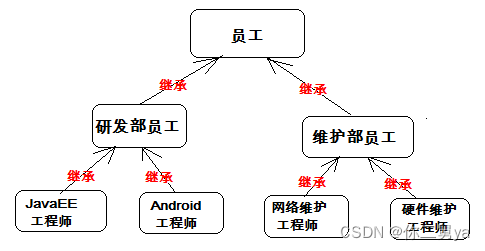1.编写程序,设计一个Animal接口,要求如下:
(1)编写Animal接口,接口中定义sleep()方法。
(2)Cat类实现Animal接口的方法,并定义另一个方法catchMouse()
(3)编写测试类Test01,使Cat对象指向父类Animal的引用 ,并通过该引用调用sleep()方法。
1.代码
interface Animal {
void sleep();
}
// 创建Cat类,实现Animal接口
class Cat implements Animal {
// 实现sleep()方法
public void sleep() {
System.out.println("猫在睡觉");
}
// 定义catchMouse()方法
public void catchMouse() {
System.out.println("猫在抓老鼠");
}
}
// 编写测试类Test01
public class Test01 {
public static void main(String[] args) {
// 创建Cat对象
Cat cat = new Cat();
// 通过父类Animal的引用调用sleep()方法
((Animal) cat).sleep();
}
}2.运行效果:
猫在睡觉
2.设计一个Shape接口和它的两个实现类Square和Circle,要求如下:
(1) Shape接口中有一个抽象方法area(),方法接收有一个double类型的参数,返回一个double类型的结果;
(2) Square和Circle中实现了Shape接口的area()抽象方法,分别求正方形和圆形的面积并返回;
(3)在Test02测试类中创建Square和Circle对象,计算边长为2的正方形面积和半径为3的圆形面积。
1.代码
interface Shape {
double area(double parameter);
}
class Square implements Shape {
public double area(double side) {
return side * side;
}
}
class Circle implements Shape {
public double area(double radius) {
return Math.PI * radius * radius;
}
}
public class Test02 {
public static void main(String[] args) {
// 创建Square对象
Square square = new Square();
// 计算边长为2的正方形面积
double squareArea = square.area(2);
System.out.println("边长为2的正方形面积为:" + squareArea);
// 创建Circle对象
Circle circle = new Circle();
// 计算半径为3的圆形面积
double circleArea = circle.area(3);
System.out.println("半径为3的圆形面积为:" + circleArea);
}
}2.运行效果:
边长为2的正方形面积为:4.0
半径为3的圆形面积为:28.274333882308138
3.编写应用程序,创建类的对象,分别设置圆的半径、圆柱体的高,计算并分别显示圆半径、圆面积、圆周长,圆柱体的体积。
(1) 编写一个圆类Circle,该类拥有:
1. 一个成员变量,radius(私有,浮点型);//存放圆的半径;
2. 两个构造方法
Circle() //将半径设为0
Circle(double r ) //创建Circle对象时将半径初始化为r
3. 三个成员方法
double getArea() //获取圆的面积
double getPerimeter() //获取圆的周长
void show() //将圆的关径、周长、面积输出到屏幕
(2) 编写一个圆柱体类Cylinder,它继承于上面的Circle类。还拥有:
1.一个成员变量,double hight (私有,浮点型); //圆柱体的高;
2.构造方法//创建Cylinder对象时将半径初始化为r,高度初始化为h
Cylinder(double r,double h)
3.成员方法
double getVolume() //获取圆柱体的体积
void showVolume() //将圆柱体的体积输出到屏幕
- 代码
class Circle {
private double radius; // 存放圆的半径
public Circle() {
this.radius = 0;
}
public Circle(double r) {
this.radius = r;
}
public double getArea() {
return Math.PI * radius * radius;
}
public double getPerimeter() {
return 2 * Math.PI * radius;
}
public void show() {
System.out.println("圆的半径:" + radius);
System.out.println("圆的面积:" + getArea());
System.out.println("圆的周长:" + getPerimeter());
}
public double area(int i) {
return 0;
}
}
// 圆柱体类
class Cylinder extends Circle {
private double height; // 圆柱体的高
public Cylinder(double r, double h) {
super(r);
this.height = h;
}
public double getVolume() {
return getArea() * height;
}
public void showVolume() {
System.out.println("圆柱体的体积:" + getVolume());
}
}
public class Test03 {
public static void main(String[] args) {
Circle circle = new Circle();
circle.show();
Cylinder cylinder = new Cylinder(5, 10);
cylinder.show();
cylinder.showVolume();
}
}2.运行效果:
圆的半径:0.0
圆的面积:0.0
圆的周长:0.0
圆的半径:5.0
圆的面积:78.53981633974483
圆的周长:31.41592653589793
圆柱体的体积:785.3981633974483
4.编写程序实现乐手弹奏乐器。乐手可以弹奏不同的乐器从而发出不同的声音。可以弹奏的乐器包括二胡、钢琴和琵琶。
(1) 定义乐器类Instrument,包括方法makeSound()
(2) 定义乐器类的子类:二胡Erhu、钢琴Piano和小提琴Violin
(3) 定义乐手类Musician,可以弹奏各种乐器play(Instrument i)
(4) 定义测试类,给乐手不同的乐器让他弹奏
1.代码
abstract class Instrument {
public abstract void makeSound();
}
class Erhu extends Instrument {
@Override
public void makeSound() {
System.out.println("二胡发出声音");
}
}
class Piano extends Instrument {
@Override
public void makeSound() {
System.out.println("钢琴发出声音");
}
}
class Violin extends Instrument {
@Override
public void makeSound() {
System.out.println("小提琴发出声音");
}
}
class Musician {
public void play(Instrument i) {
i.makeSound();
}
}
public class Test04 {
public static void main(String[] args) {
Musician musician = new Musician();
Instrument erhu = new Erhu();
Instrument piano = new Piano();
Instrument violin = new Violin();
musician.play(erhu);
musician.play(piano);
musician.play(violin);
}
}2.运行效果:
二胡发出声音
钢琴发出声音
小提琴发出声音
5.编写程序描述影视歌三栖艺人,需求说明:请使用面向对象的思想,设计自定义类,描述影视歌三梄艺人。
(1)分析影视歌三栖艺人的特性
1.可以演电影
2.可以演电视剧
3.可以唱歌
(2)定义多个接口描述特性
1.演电影的接口-----方法:演电影
2.演电视剧的接口-----方法:演电视剧
3.唱歌的接口-----方法:唱歌
(3)定义艺人类实现多个接口
1.代码
interface MovieActor {
void actInMovie();
}
interface TVSeriesActor {
void actInTVSeries();
}
interface Singer {
void sing();
}
class MultiRoleArtist implements MovieActor, TVSeriesActor, Singer {
@Override
public void actInMovie() {
System.out.println("演电影");
}
@Override
public void actInTVSeries() {
System.out.println("演电视剧");
}
@Override
public void sing() {
System.out.println("唱歌");
}
}
public class Test05 {
public static void main(String[] args) {
MultiRoleArtist artist = new MultiRoleArtist();
artist.actInMovie();
artist.actInTVSeries();
artist.sing();
}
}
2.运行效果:
演电影
演电视剧
唱歌
6.编写 Java 程序,定义Test07类进行测试。自定义一个异常类NoThisSoundException和Player类,在Player的play()方法中使用自定义异常,要求入下:
(1) NoThisSongException继承Exception类,类中有一个无参和一个接收一个String类型参数的构造方法,构造方法中都使用super关键字调用父类的构造方法。
(2) Player类中定义一个play(int index)方法,方法接收一个int类型的参数,表示播放歌曲的索引,当index>10时,paly()方法用throw关键字抛出NoThisSongException异常,创建异常对象时,调用有参的构造方法,传入“您播放的歌曲不存在”。
(3)在测试类中创建Player对象,并调用play()方法测试自定义的NoThisSongException异常,使用try…catch语句捕获异常,调用NoThisSongException的getMessage()方法打印出异常信息。
1.代码
// 自定义异常类NoThisSoundException
class NoThisSoundException extends Exception {
public NoThisSoundException() {
super();
}
public NoThisSoundException(String message) {
super(message);
}
}
// Player类
class Player {
public void play(int index) throws NoThisSoundException {
if (index > 10) {
throw new NoThisSoundException("异常信息:您播放的歌曲不存在");
}
}
}
// 测试类
public class Test07 {
public static void main(String[] args) {
Player player = new Player();
try {
player.play(11);
} catch (NoThisSoundException e) {
System.out.println(e.getMessage());
}
}
}2.运行效果:

三、思考题1,编写程序,根据下图所示的类族,分别定义员工类、研发部员工类、维护部员工类等,并写出相关测试结果。
注:掌握定义类的语法结构、掌握抽象类的使用、掌握类的继承。

1.代码
class Employee {
private String name;
private int age;
private String department;
public Employee(String name, int age, String department) {
this.name = name;
this.age = age;
this.department = department;
}
public String getName() {
return name;
}
public void setName(String name) {
this.name = name;
}
public int getAge() {
return age;
}
public void setAge(int age) {
this.age = age;
}
public String getDepartment() {
return department;
}
public void setDepartment(String department) {
this.department = department;
}
@Override
public String toString() {
return "Employee{" +
"name='" + name + '\'' +
", age=" + age +
", department='" + department + '\'' +
'}';
}
}
class RDEmployee extends Employee {
private String position;
public RDEmployee(String name, int age, String department, String position) {
super(name, age, department);
this.position = position;
}
public String getPosition() {
return position;
}
public void setPosition(String position) {
this.position = position;
}
@Override
public String toString() {
return "RDEmployee{" +
"name='" + getName() + '\'' +
", age=" + getAge() +
", department='" + getDepartment() + '\'' +
", position='" + position + '\'' +
'}';
}
}
class MWEmployee extends Employee {
private String skill;
public MWEmployee(String name, int age, String department, String skill) {
super(name, age, department);
this.skill = skill;
}
public String getSkill() {
return skill;
}
public void setSkill(String skill) {
this.skill = skill;
}
@Override
public String toString() {
return "MWEmployee{" +
"name='" + getName() + '\'' +
", age=" + getAge() +
", department='" + getDepartment() + '\'' +
", skill='" + skill + '\'' +
'}';
}
}
public class TestEmployee {
public static void main(String[] args) {
Employee employee = new Employee("张三", 30, "研发部");
System.out.println(employee);
RDEmployee rDEmployee = new RDEmployee("李四", 28, "研发部", "高级工程师");
System.out.println(rDEmployee);
MWEmployee mwEmployee = new MWEmployee("王五", 35, "维护部", "网络工程师");
System.out.println(mwEmployee);
}
}2.运行效果:
Employee{name='张三', age=30, department='研发部'}
RDEmployee{name='李四', age=28, department='研发部', position='高级工程师'}
MWEmployee{name='王五', age=35, department='维护部', skill='网络工程师'}
























 1035
1035











 被折叠的 条评论
为什么被折叠?
被折叠的 条评论
为什么被折叠?










